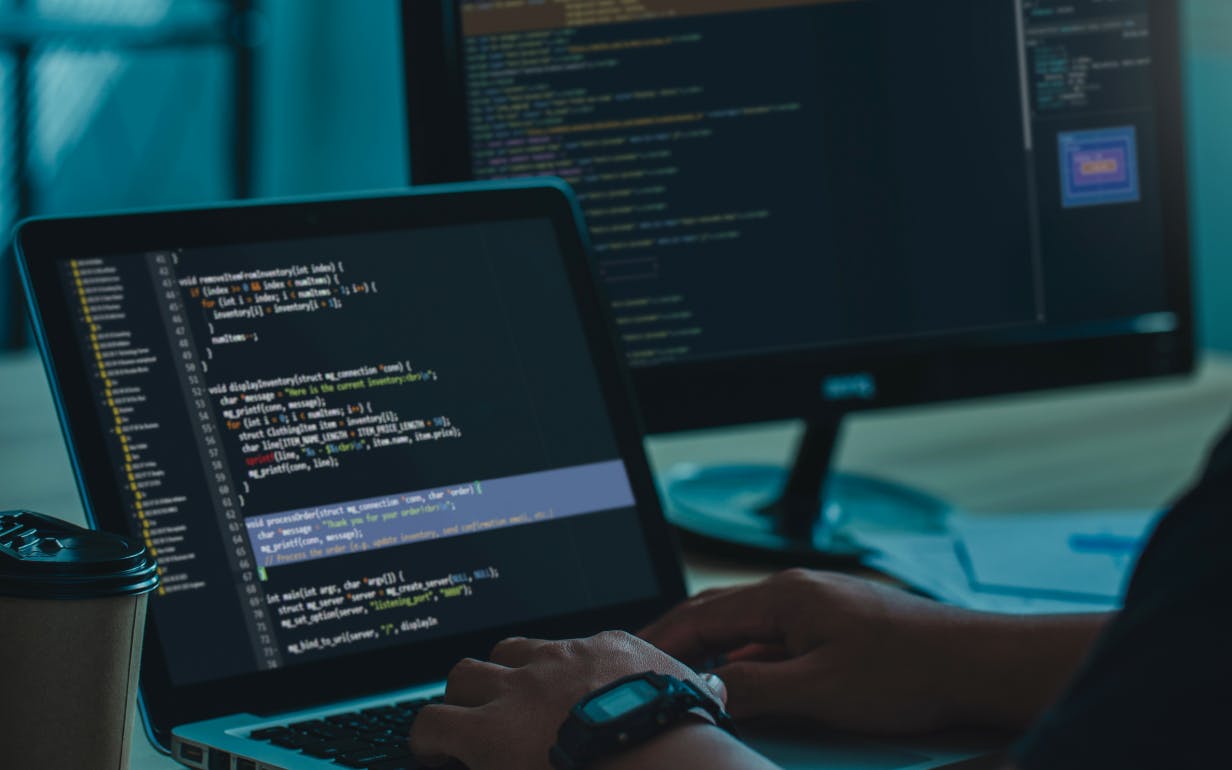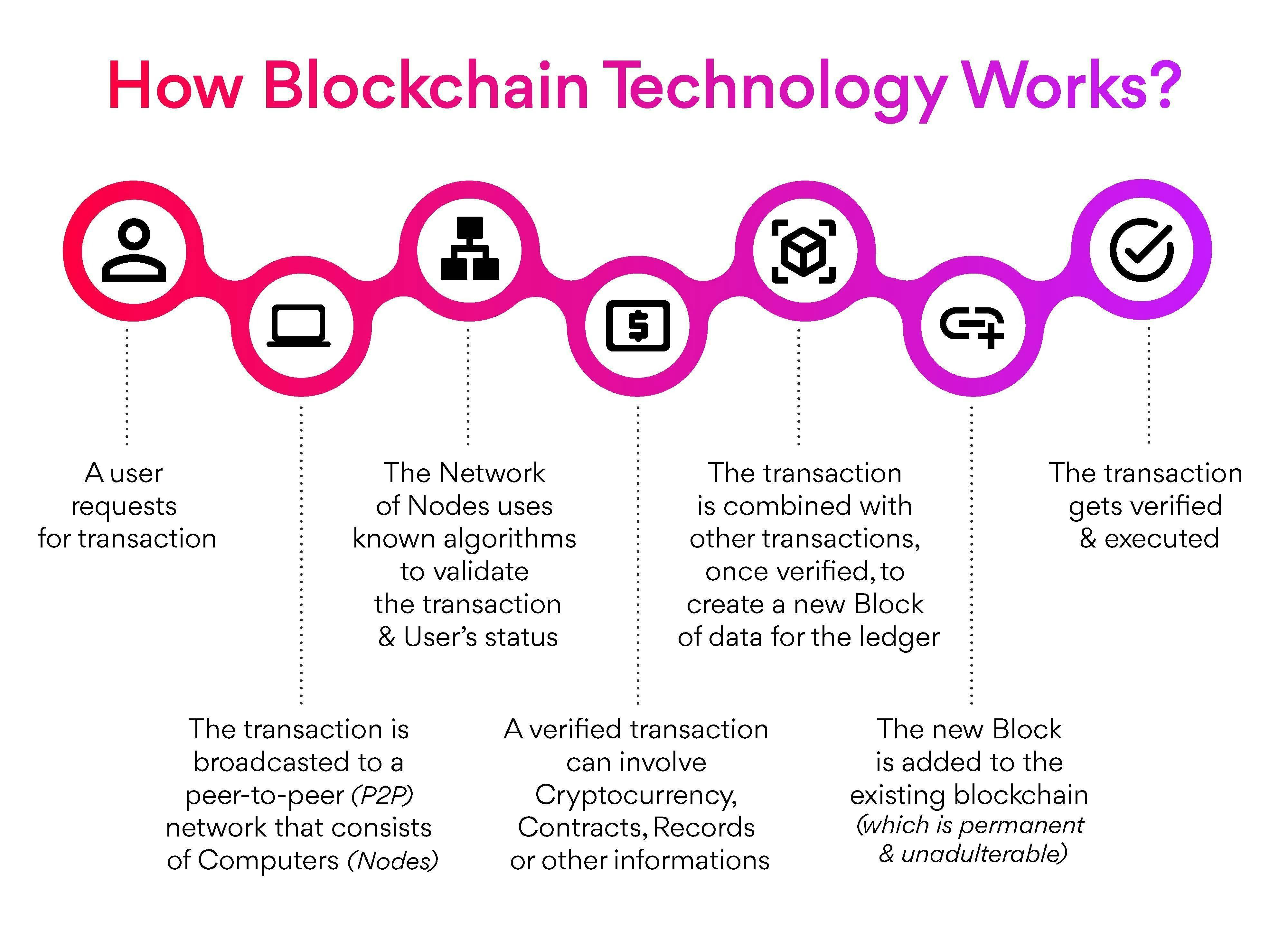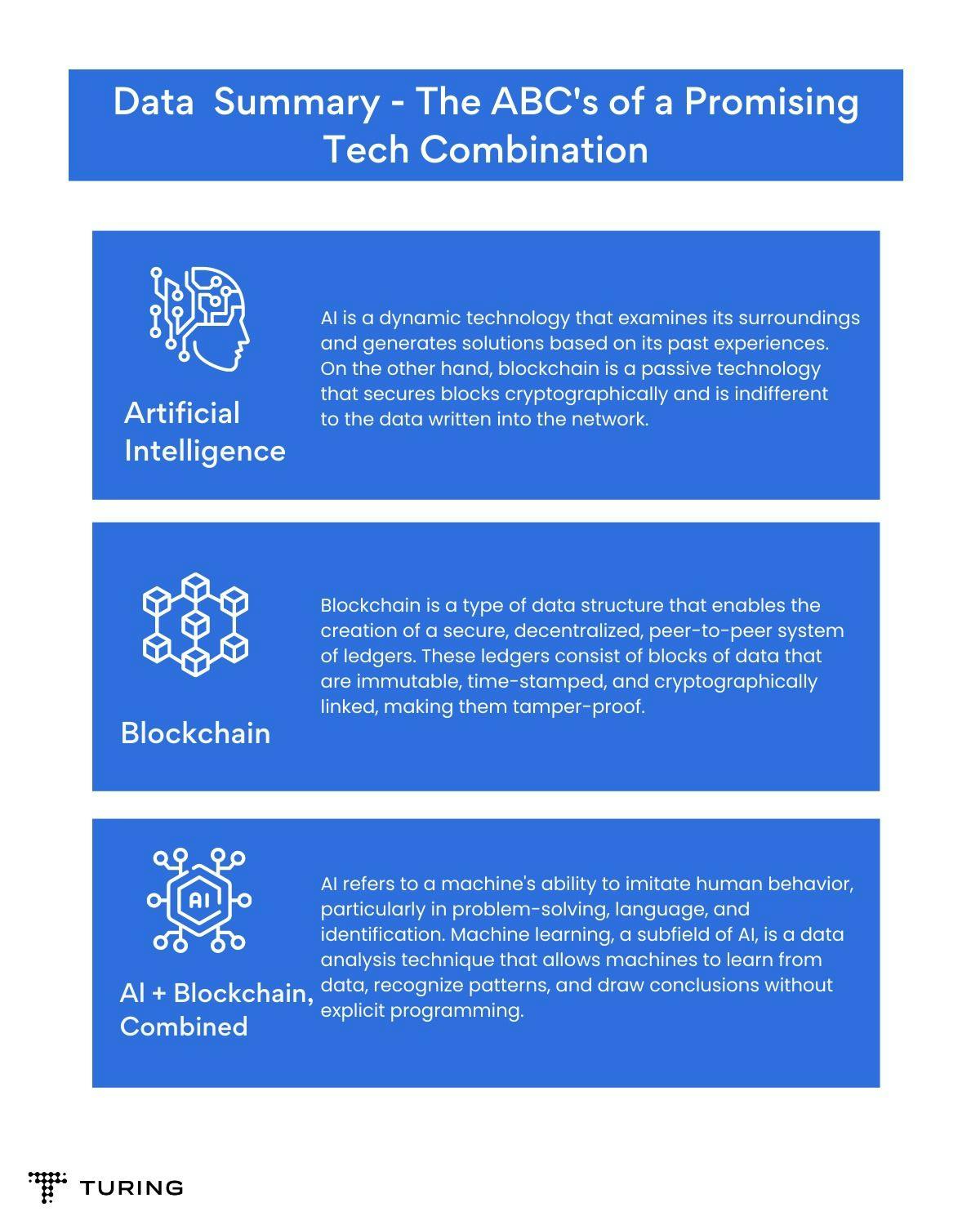The Future of AI and Blockchain Technology & How It Complements Each Other?
•10 min read
- Languages, frameworks, tools, and trends

Blockchain and AI are the two most important and emerging technologies. Blockchain is versatile and is easy to apply whereas AI has surpassed all its limitations of experimenting performances in the labs. Both are embedded with the recent technological developments, though both have different roots.
Blockchain is considered a shared and permanent ledger that will be used for the encryption of data in the future. AI engine, on the other hand, enables an individual to analyze and make decisions from the collected data. It is worth mentioning that each technology has its multiple complexions, but artificial intelligence and blockchain together will provide many benefits.
From a survey, it is clear that blockchain will make AI more consistent, understandable, and logical. When you want to understand and trace back why decisions are made through machine learning, then you have to check its ledger. The ledger holds all the records of the data which will help you with your decision-making process.
What is blockchain?
Blockchain is an immutable and shared ledger that will provide an immediate, shared, and transparent exchange of encrypted data simultaneously to different parties as they initiate and complete transactions. A blockchain network can track multiple transactions, orders, accounts, payments, production, and so on.

As the members with granted permission share a single view of the output through blockchain solutions, they gain confidence and trust in their transactions with other businesses and get new profound efficiencies, insights, and opportunities. Blockchain is difficult to manipulate, deceive, or hack, making it a very efficient storing front.
Bitcoin is one of the best examples that prove the safety and security of blockchain technology. It is a promising and revolutionary technology. It reduces uncertainty, provides total transparency, and prevents fraud. The inherent security features make it the most ideal technology.
What is artificial intelligence?
Artificial intelligence leverages computers, data, and machines to mimic the problem-solving and decision-making capabilities of the human mind. It also encompasses the subfields of machine learning and deep learning technologies. These technologies use AI algorithms to train data for making predictions and classifications.

The benefits of AI solutions include automated decision-making, recurring tasks, and reducing human errors. AI fuels the development of technologies like big data, the internet of things (IoT), and robotics. In the future, the combining effects of AI and blockchain technology will continue to be a technical trailblazer.
Interlinking of the blockchain technology and AI:
Blockchain technology is interlinked with AI in many ways. Below are the major integrations:
1. Transparent data source
You need ample data to train an AI application. As blockchain is the most transparent technology, it is a reliable source of refined data. Due to the traceability of nodes, the source of data can be verified efficiently.
2. Autonomous system
The decentralized ledger technology ensures that no single server handles all the operations of the AI application. The autonomous system drives the decentralization for managing the AI training and operations without being supervised.
3. Privacy protection
Cryptographic techniques strengthen privacy throughout the network which runs AI training and operations. When you have a robust privacy system you can train and supply AI systems as they are competitive and have higher complexity.
4. Distributed computing power
To train and maintain AI, you require a lot of firepowers. Blockchain technology takes that responsibility and helps to get through it. It also takes care of the space requirements like hardware and software, storage, and maintenance cost.
5. Security
Blockchain’s smart contracts are not secure enough. The blockchain revolves around the rigidness of the contract, when there are loopholes you can exploit and harm the applications easily. For minimizing such vulnerabilities, AI is used to generate more secure and smart contracts.
6. Reading efficiency
The low query performance often limits blockchains as they have limitations in their data storage modes. The blockchain applications sacrifice the reading efficiency for achieving a more write-intensive approach with level DB-a write-intensive DMS.
While using AI, the data storage methods help to enhance the usage of blockchain. A proposed novel TTA-CB protocol lowers the issues of data storage through PSO algorithms. When you do rigorous testing and training, AI eventually helps in improving the speed of data queries.
7. Authenticity
Blockchain’s digital record provides insights into the AI framework and the provenance of the data which is used, it also addresses the challenges of explainable AI. It helps you in improving your trust in data integrity and the recommendations the AI provides. When you are using blockchain for storing and distributing AI modes it provides an audit trail, and pairs blockchain and AI to enhance data security.
8. Augmentation
AI reads data comprehensively and rapidly. It also understands and processes the data at a great speed by bringing higher intelligence to the blockchain-based business networks. When you provide access to larger data within or outside the organizations, blockchain will help the AI scale and provide more actionable insights, manage model sharing and data usage, and create a transparent and trustworthy data economy.
9. Automation
Automation, AI, and blockchain will bring newer values to business processes that span different parties like adding, removing friction, and increasing speed and efficiency. AI models embedded in smart contracts execute on blockchain to resolve disputes and select the most sustainable shipping methods.

Ideal model
For the past few years, researches show that there is a link between blockchain and AI. Both technologies have always functioned individually, but things are changing pretty quickly. We find that most AI applications are making their way to the field of big data, the major reason behind it is the huge data that is generated by the AI devices.
Data handling is a major topic while dealing with businesses and blockchain and AI together can make an imperative impact in handling data and addressing other data-related issues. The data will be broken into small parts in a blockchain and distributed across the network.
There is no central authority for governing the data. Each computer will keep a total copy of the ledger so that the data is not lost. If you prefer an ecosystem for private data that is processed with AI and offers a better user experience, you should choose blockchain. For example, in the healthcare industry, the data provides a detailed summary of items in the health sector. With this vast data, you can analyze, discover, diagnose, and prevent diseases.
The use of blockchain with AI can impact different industries and provide a dynamic way to derive privacy, energy, control data regulation, security, and scalability.
AI uses machine learning to promote data performance, efficiency, and accuracy. Whereas, blockchain looks for power and energy to execute and run a network of computers. Combining both blockchain and AI makes the process smoother and more viable. Here are some benefits of integrating blockchain with artificial intelligence.
How do AI and blockchain technology complement each other?
Blockchain is an expensive medium of storing vast data in a traditional method. When you are keeping larger files on the Bitcoin blockchain, it is prohibitively expensive as they are the one-megabyte size per block. For addressing this issue, data is stored on a decentralized storage medium, which hashes the data and connects it to the blockchain blocks or uses the smart contract code from within.
When you merge artificial intelligence and blockchain technologies, decentralized AI apps and algorithms are built with access to an identical vision of a trusted and shared data platform for storing your knowledge, records, and decisions. This platform is useful when you keep reliable records of all the AI algorithms before, during, and after the learning and decision-making process.
The idea of a decentralized AI system
A decentralized AI system is a concept that will provide processor independence without any cons of sharing aggregate data. It will let the user process the information independently across different computing devices. With that process, you can get different findings, which you can then evaluate and find out fresh solutions to problems that a centralized system will not be able to solve.
Decentralized AI system has higher possibilities in the field of science, enterprises, and also to meet public requirements. Overall, it allows the devices to overcome their difficulties through real-world challenges, trial-and-error, and reasoning while recording all those results. People may get a clear and consistent structure that explains how things function.
AI approaches the use of blockchain for providing decentralized learning by facilitating the secure sharing of knowledge and trust in the decision-making process. It will provide a large autonomous contribution, coordination, and voting in the future decision-making process. But, systems with significant computing power, rapid connectivity, and storage are required to fully realize the effects of decentralized AI.

Three security methods of decentralized AI platform
1. SMPC (Secured Multi-Party Computations)
The security method is secured multi-party computations, which will allow you to make statements about datasets without revealing the dataset itself. SMPC is at the heart of the blockchain technologies like Enigma. This method will assure that the public function is computed with private data while keeping the inputs hidden. As a result, SMPC architects will enable the AI models development without disclosing datasets to external parties.
2. GAN cryptography
GAN cryptography is a new AI method to safeguard communication between parties that uses it. Google introduced GAN cryptography. The research about it shows how to protect communication channels from attackers who try to break security systems with neural networks. These networks will create a new type of encryption and decryption on the run.
3. Homomorphic encryption
Homomorphic encryption is different from other encryption types. It enables computation on encrypted data. And this computation doesn’t require any secret key. The output of such computation is encrypted, and the owner must use the secret key for decrypting it later.
Homomorphic encryption is the most significant advancement in cryptography. The decentralized AI application will allow users to submit data to train the models while keeping it private from others.
A futuristic approach
When artificial intelligence and blockchain are combined, they can help you build an immutable, safe, and decentralized system. This method will lead to major data and information security advances in different industries.
But, the convergence of artificial intelligence and blockchain technology is still unexplored. Even though the integration of the two technologies has attracted considerable attention. Also, projects are devoted to the ground-breaking combination that is available. Bringing the two technologies together will enable data to be used under unimaginable circumstances.
With each of these technologies affecting and executing data in different ways, their collaboration will make a logical explanation. It has the potential to push data exploitation to newer heights.
FAQs:
1. What is the three-way relationship between blockchain AI and the cloud?
Blockchain, AI, and the cloud are the pillars of the industrial revolution. These are financial services individually, but combined they can help you achieve greater value and allow you to understand any data a business holds. These three together will help in radically transforming and enhancing the current processes, developing new innovative products, and creating a new business model.
2. Which is the best artificial intelligence or blockchain technology?
AI will help in concentrating power for a few organizations that can source and process large data. Blockchain technology will help individuals secure their personal data while letting the agents generate and exchange economic value at small operational scales. With this, you can understand that AI and blockchain both have dynamic opposition to each other.
3. What other technology combined with blockchain would help?
Artificial intelligence and blockchain technology when combined will provide a powerful combination that will help you in improving your virtual look. It will enhance everything from supply chain management to financial security. The integration will affect many aspects including security.
AI can effectively mine through huge amounts of data and create a new scenario and discover patterns as per the data behavior. Blockchain will help in removing bugs and fraudulent data. You can create new patterns and classifiers using AI and verify them on a decentralized blockchain infrastructure for verifying their authenticity.
4. How can we utilize the blockchain to build a smart economy for AI services?
We can utilize the power of blockchain technology, distributed ontology, trusted execution, and advanced cryptography you can develop a novel infrastructure that will support the AI revolution. The system will provide a fluid medium where the AI agents will collaborate to provide advanced features.
5. How would the client benefit by using blockchain technology to train the machine learning model?
Blockchain technology will make sure that the automation process is quicker than centralized databases. It will ensure that the automation process can be manipulated by a human as per their scenarios. It will ensure that only admins will be able to modify the data that is sent to the machine learning model. It will also make sure that the model training occurs on a consistent and timely basis.